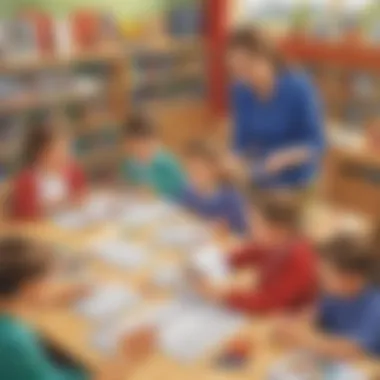Unlocking Numeracy: Tailored Methods for Special Needs Students


Interactive Learning Games
Introduction
Understanding Special Needs Students
Types of Special Needs
In the context of special needs education, various conditions like autism spectrum disorder and ADHD present unique challenges. These differences in learning styles require specialized attention when teaching numeracy. Understanding the intricacies of each condition enables educators to tailor their approaches effectively, fostering a conducive learning environment. While each type of need demands specific strategies, the overall goal remains consistent - to facilitate meaningful learning experiences for every student.
Impact on Learning
The impact of special needs on learning is profound, shaping the way students engage with mathematical concepts. Challenges such as attention deficits or sensory sensitivities influence how numerical information is processed. By acknowledging and addressing these impacts, educators can adapt their teaching methods to optimize learning outcomes. Utilizing a personalized approach that caters to individual needs is essential for overcoming these challenges and creating a supportive learning environment.
Importance of Numeracy Skills
Cognitive Development
Numeracy skills play a pivotal role in enhancing cognitive development among special needs students. By engaging in counting activities, students stimulate critical thinking, problem-solving, and memory retention. This cognitive workout not only strengthens mathematical abilities but also nurtures overall cognitive functions. Integrating numeracy skills into the curriculum promotes holistic development, equipping students with essential cognitive tools for academic success.
Daily Life Applications
The practical applications of numeracy skills extend far beyond the classroom, impacting various aspects of daily life. From shopping to time management, counting forms the basis of essential life skills. For special needs students, mastering numeracy is especially empowering as it enhances their independence and confidence in navigating real-world scenarios. By emphasizing the relevance of numeracy in daily activities, educators can instill a sense of purpose and practicality in their teachings, fostering a profound understanding of mathematical concepts.
Adapting Teaching Methods


Visual Aids and Manipulatives
Use of Counting Blocks
Interactive Number Charts
Incorporating interactive number charts offers a dynamic and engaging method for reinforcing counting skills among special needs students. These digital tools provide visual representations of numerical sequences and patterns, enhancing comprehension and retention of mathematical concepts. The interactive nature of number charts allows for customization based on individual learning needs, enabling educators to adapt the material to suit each student's pace and preferences. While interactive number charts facilitate interactive learning experiences, it is essential to consider the technical proficiency and accessibility of such resources to ensure seamless integration into the educational curriculum.
Sensory-Friendly Approaches
Utilizing Tactile Materials
Integrating tactile materials into the teaching strategy for special needs students promotes sensory engagement and kinesthetic learning experiences. Tactile materials, such as textured surfaces, manipulative objects, and sensory tools, stimulate multiple sensory modalities, enhancing cognitive processing and memory retention. By incorporating tactile materials, educators can create a multisensory environment that accommodates diverse learning preferences and optimizes the learning potential of students with special needs. However, it is crucial to consider individual sensitivities and preferences when introducing tactile materials to ensure a comfortable and inclusive learning environment.
Incorporating Movement
Incorporating movement into the learning activities for special needs students serves as a beneficial strategy for promoting physical engagement and cognitive development. Movement-based approaches, such as physical exercises, dance routines, and interactive games, enhance kinesthetic awareness and gross motor skills while reinforcing numeracy concepts. By incorporating movement into the instructional design, educators can cater to the diverse needs of students with special needs, providing an inclusive and dynamic learning experience. Despite its advantages in promoting active learning, educators should be mindful of adapting movement-based activities to suit the unique abilities and comfort levels of each student.
Personalized Learning Plans
Individualized Instruction
Tailoring instruction to meet the individual needs and abilities of special needs students is a fundamental component of personalized learning plans. Individualized instruction enables educators to customize teaching strategies, pacing, and content to align with the learning preferences and challenges of each student. By providing targeted support and differentiated instruction, educators can address the specific strengths and areas of improvement for every student, fostering a personalized learning journey that maximizes academic growth and confidence. The adaptive nature of individualized instruction allows for flexibility and responsiveness to the diverse learning profiles and needs of special needs students.
Tailored Progress Tracking


Effective progress tracking is essential in monitoring the academic development and growth of special needs students within a personalized learning plan. Tailored progress tracking involves implementing assessment tools, data collection methods, and performance metrics to evaluate the individualized goals and objectives set for each student. By tracking progress systematically, educators can identify areas of improvement, modify instructional approaches, and celebrate achievements, providing continuous feedback and support to special needs learners. However, it is important to strike a balance between data-driven assessment and qualitative observations to ensure a holistic and comprehensive view of student progress.
Utilizing Specialized Resources
Digital Learning Tools
Online Learning Platforms
Furthermore, Online Learning Platforms emerge as another key component in the landscape of digital learning tools for special needs students. These platforms provide a comprehensive virtual learning environment where students can access a wide array of resources, including interactive lessons, practice exercises, and educational games. The flexibility and accessibility offered by online platforms cater to varying learning abilities, enabling students to engage with numerical concepts in a more tailored and immersive manner. While Online Learning Platforms present numerous advantages in terms of convenience and adaptability, their effectiveness in promoting numeracy skills among special needs students reinforces their significance in the educational domain.
Assistive Technology
Incorporating assistive technology plays a vital role in fostering inclusive education for special needs students, particularly in the context of numeracy instruction. One notable form of assistive technology is Speech-to-Text Software, which assists students with communication or motor challenges in expressing numerical concepts effortlessly. This software recognizes spoken words and transcribes them into text, facilitating seamless participation in math-related activities. By minimizing barriers to communication, Speech-to-Text Software enhances students' ability to engage with mathematical concepts, promoting a more inclusive and supportive learning environment.
Adaptive Calculators
Moreover, the integration of Adaptive Calculators as assistive technology presents another avenue for enhancing numeracy skills among special needs students. These calculators are equipped with features that cater to diverse learning needs, such as large buttons, audio output, and customizable interfaces. By accommodating different learning styles and requirements, Adaptive Calculators empower students to perform mathematical calculations with increased independence and accuracy. The adaptability of these calculators makes them indispensable tools in enabling special needs students to overcome challenges and develop critical numeracy skills.
Collaboration with Specialists
Collaboration with specialists in the field of special education brings an added layer of support and expertise to the teaching of counting to special needs students. By involving Occupational Therapists in the instructional process, educators can gain valuable insights into creating a conducive learning environment that addresses students' physical and sensory needs. The expertise of Occupational Therapists can inform the design of inclusive learning activities and spaces, promoting student engagement and comfort during math instruction.
Consulting Speech Therapists
Equally essential is the collaboration with Speech Therapists, who play a crucial role in supporting students with speech and language challenges in numeracy instruction. Consulting Speech Therapists enables educators to incorporate tailored strategies that facilitate effective communication of mathematical ideas and concepts. Through specialized interventions and techniques, Speech Therapists empower students to articulate numerical reasoning and engage meaningfully with mathematical content. By leveraging the expertise of Speech Therapists, educators can enhance the communication skills of special needs students, fostering their mathematical development and overall learning experience.


Monitoring Progress and Adjusting Strategies
Tracking Numeracy Development
Assessment Tools
Assessment tools play a crucial role in evaluating the numerical proficiency of special needs students. These tools are specially designed to gauge the cognitive understanding and mathematical abilities of each learner, providing valuable insights into their progress and challenges. One key characteristic of assessment tools is their versatility, allowing educators to employ various techniques such as quizzes, tests, and practical demonstrations to assess numeracy development. The adaptability of assessment tools makes them a popular choice in special needs education as they cater to individual learning styles and pace. Their unique feature lies in their ability to provide actionable data for educators to refine their teaching strategies, offering a comprehensive view of each student's mathematical skills. While assessment tools offer invaluable benefits in tracking numeracy development, some challenges include the need for continuous refinement to align with evolving educational standards.
Observational Techniques
In addition to formal assessments, observational techniques serve as a complementary method to track numeracy development in special needs students. These techniques involve the astute observation of students during mathematical activities, enabling educators to gauge their mathematical reasoning, problem-solving skills, and overall engagement. The key characteristic of observational techniques is their real-time feedback, allowing educators to adjust teaching strategies immediately based on students' responses and interactions. This immediacy renders observational techniques a beneficial choice for this article as they provide insights into students' practical application of counting skills. The unique feature of observational techniques lies in their ability to capture non-verbal cues and nuances in students' learning behavior, offering a holistic perspective on their mathematical development. While observational techniques enhance the understanding of numeracy progress, challenges may arise in ensuring consistent and objective observations across different learning environments.
Flexibility in Teaching Approaches
Responsive to Student Needs
Modifying Lesson Plans
Modifying lesson plans is an integral aspect of fostering flexibility in teaching approaches for special needs students. This adaptive strategy involves adjusting instructional content, pacing, and activities to accommodate the varied learning needs and preferences of students. The key characteristic of modifying lesson plans is its versatility, allowing educators to customize learning experiences to suit individual abilities and interests. This flexibility in teaching approaches is a popular choice for this article as it promotes adaptability and responsiveness in addressing the diverse needs of special needs learners. The unique feature of modifying lesson plans lies in its ability to cater to changing student requirements, ensuring that instructional strategies remain relevant and engaging. While modifying lesson plans enhances the efficacy of teaching counting, challenges may arise in maintaining coherence and continuity in the learning journey of students with varying needs.
Conclusion
Within the realm of educating special needs students, the conclusive sector of this article emphasizes the pivotal role of empowering these learners through tailored strategies targeted at cultivating their numeracy skills. By adhering to the various methodologies discussed throughout this composition, educators and caregivers can significantly impact the academic journey of special needs students, fostering an environment conducive to their overall development and progress. The importance of instilling a sense of confidence and independence within these individuals cannot be overstated, as such attributes are fundamental in nurturing their cognitive growth and adaptive capabilities within educational settings. Implementing approaches that encourage confidence-building and independence not only boosts academic performance but also enhances the self-esteem and autonomy of the students, cultivating a positive and enriching learning experience.
Empowering Special Needs Students
Building Confidence
Exploring the facet of building confidence among special needs students unveils a fundamental aspect crucial to their academic advancement. Confidence serves as a catalyst for motivation, enabling students to engage more actively in their learning processes and persevere through challenges. In the context of this article, instilling confidence involves creating a supportive and encouraging environment where students feel empowered to explore mathematical concepts and numerical literacy without fear of judgment or failure. The key characteristic of building confidence lies in its ability to cultivate a resilient mindset within students, facilitating a positive attitude towards learning and problem-solving. Recognizing the uniqueness of each student's learning journey, building confidence allows educators to tailor their approach to address specific challenges and enhance learning outcomes. Despite some disadvantages like the requirement of additional time and effort, the advantages of fostering confidence in special needs students are manifold, contributing significantly to their overall academic growth and personal development.
Fostering Independence
The concept of fostering independence in special needs students stands as another cornerstone in the educational landscape, particularly concerning the cultivation of numeracy skills. Fostering independence entails equipping students with the tools and strategies to navigate mathematical tasks autonomously, promoting self-reliance and critical thinking abilities. In the context of this article, fostering independence plays a crucial role in empowering students to take ownership of their learning journey, instilling a sense of responsibility and agency in their academic pursuits. The unique feature of fostering independence lies in its capacity to nurture problem-solving skills and decision-making capabilities, enabling students to approach mathematical challenges with confidence and resilience. While fostering independence may pose challenges in terms of initial supervision and guidance, its advantages in promoting student autonomy and self-efficacy outweigh any potential drawbacks. By encouraging independence, educators can cultivate a sense of empowerment and self-advocacy in special needs students, fostering an environment conducive to their sustained academic success.















